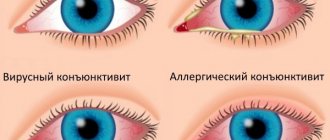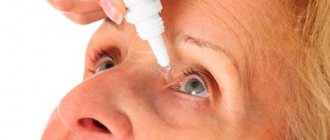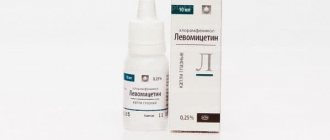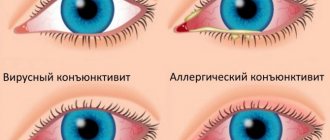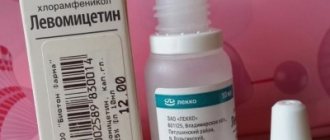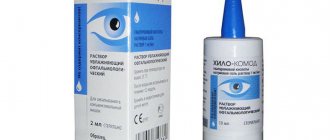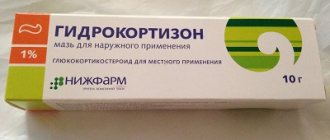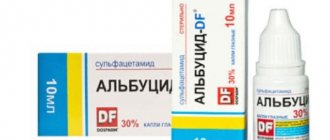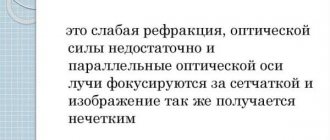Inflammatory process of the eye is quite common in newborns. And new moms and dads need to navigate the main manifestations of this inflammation. This is necessary in order to notice changes in time and quickly seek help from a doctor. It is necessary to eliminate the disease, as they say, at the root, without starting the process, and not suffer from the consequences of late treatment.
Timely examination and adequate treatment of colpitis and sexually transmitted infections in a pregnant woman is the main and necessary prevention of inflammatory eye diseases in a newborn. After all, during a natural birth, a child can become infected with mucous membranes from the microflora of the mother’s birth canal.
In this article, I will introduce you to the main manifestations of the inflammatory process in the eyes of babies, the features of eye hygiene, and will help you understand the many eye drops for newborns.
Manifestations of eye inflammation
It should be clarified that the causes of inflammation of the membranes of the eye can be bacteria, viruses, or an allergic reaction to various foreign agents. An inflammatory process of an allergic nature, as a rule, is not typical for a newborn. It takes enough time and repeated contact with the allergen to develop.
Inflammation caused by bacteria is manifested by redness and swelling of the eyelid, expansion of the vascular network of the white part of the eye, tearing and suppuration. As a result, the pus dries and sticks the eyelashes together. This is accompanied by itching, a feeling of sand or a foreign body in the eye.
This, of course, causes discomfort for the baby, and he will show this by anxiety and capricious behavior. The child will constantly pull his hands towards his eyes and try to rub his eyes. The baby’s eyes especially swell and “swim” with pus after sleep. Often a child cannot open his eyes due to glued eyelashes. It’s simply impossible to look at this calmly.
And in such cases, if it is not possible to immediately see a doctor, parents need to look for information on their own, but not on mommy forums, but on specialized sites where there are recommendations from specialists and clear explanations of what is possible and what is not.
With inflammation of the conjunctiva of the eye of a viral nature, the changes occur almost the same as with a bacterial process. The difference is that the disease is preceded by a viral infection of the upper respiratory tract. From the first days, lacrimation appears, and then pus may appear in the eyes. Everything occurs in combination with swelling of the nasal mucosa, since the nose and eye are connected by the nasolacrimal duct.
Often viral conjunctivitis is complicated by the addition of bacteria to the inflammatory process. This happens due to the fact that viruses seem to disarm the platform, on which any bacteria can then freely land. Only a doctor can tell what process is going on in your child, having previously examined and examined the baby.
Useful: How to wash the eyes of a newborn child with furatsilin?
You need to know all this in order to accidentally, for example, on the advice of a friend, not treat a bacterial process with antiviral drops or vice versa. It is necessary to take a competent approach to the choice of medications and be guided by the principle of “do no harm.”
It is worth noting that dacryocystitis (inflammation of the lacrimal sac) very often occurs in newborns due to blockage of the nasolacrimal duct. As a rule, the cause of this condition is a congenital adhesion (film) in the cavity of the lacrimal canal.
Dacryocystitis itself does not cause the child any anxiety, pain, itching, or visual impairment.
However, the presence of such adhesions leads to stagnation of tears in the baby’s eyes. And if there is no adequate outflow of tear fluid, sooner or later bacterial flora will join. As a result, the eye gets stuck and quite a lot of pus is released.
The gradual expansion of this channel occurs independently until the baby is 3 months old, including due to the natural growth rate of the child.
There is a high probability that the adhesive will break through on its own. If this does not happen, the eyes are constantly swollen, and the treatment gives a short-term effect, then they resort to surgical treatment (probing) of the canal with a special probe.
The best way to avoid probing the nasolacrimal duct is to regularly massage the lacrimal sac. The purpose of the massage is to increase the pressure in the canal in order to break through the adhesions and allow the outflow of tear fluid.
Indications for eye drops for newborns
Recently, neonatologists have been strongly recommending eye drops for a newborn in the first minutes after delivery. For this, antiseptic or antibacterial drops are used. This feature is associated with a high risk of infection with dangerous microorganisms when the baby passes through the birth canal. It is especially dangerous not to carry out prophylaxis if traces of ureaplasma are detected in the mother’s blood, protein is elevated, or there is chronic candidiasis.
Indications for the use of eye drops for newborns:
- redness;
- the appearance of purulent crusts after sleep;
- swelling of the upper or lower eyelid;
- lacrimation.
When the inflammatory process begins, the baby may show anxiety: pulls his hands to his face and eyes, cries for no apparent reason, refuses the breast or pacifier. Parents notice a lot of discharge in the corners, which quickly dries out and causes the eyelashes to stick together.
How to wash a newborn's eyes
Furacilin is more often used to wash the eyes than chamomile decoction and brewed tea. And this is correct, since furatsilin is an antimicrobial agent. Furacilin is available in the form of an aqueous solution and in tablets, which parents need to dissolve themselves.
The tablets take quite a long time to dissolve. It is better to grind them first. This will save you time. Concentration of the solution: one tablet of furatsilin is needed per 100 ml of warm (37°C) boiled water.
Be sure to wash your hands with soap and water before rinsing your eyes. Moisten a sterile cotton swab with furatsilin so that the solution does not drip from it. Rub the eye from the outer edge of the eye towards the nose, slightly moving the lower eyelid.
Use a new swab for each eye. You should wash your eyes 3-4 times a day.
If there is too much discharge from the tear duct, you have to wipe the eye frequently, but the effect is still short-lived, then you need to squeeze out the accumulated contents from the tear duct before rinsing.
To do this, you need to apply light pressure several times along the edge of the bridge of the nose towards the eye (from bottom to top). The procedure, of course, is incomprehensible and not very pleasant for the child, but the eye will remain clean longer.
Useful: How to treat herpes in a child under one year old?
Causes of conjunctivitis in children
A child may get conjunctivitis for the following reasons:
- Decreased immunity.
- Hypothermia.
- Rubbing your eyes with unwashed hands.
- Allergy.
- Ingress of microbes:
- by airborne droplets in enclosed spaces (kindergartens, schools, shops), in transport and other places where people are in large numbers;
- as a result of sharing objects with an infected person.
Depending on the causative agent, conjunctivitis is divided into the following types:
| Type of conjunctivitis | Pathogens |
| 1. Bacterial |
|
| 2. Viral |
|
| 3. Allergic |
|
For the pathogenic bacterium to enter the mucous membrane of the eye, it is enough to touch the eyes with unwashed hands.
The development of the disease in infants is aggravated by excessively dry air in the room where they are located. An additional factor is the physiological absence of tears in the first 2 weeks of a child’s life. Children under 4 years of age are more susceptible to bacterial and viral conjunctivitis.
The spread of the disease occurs very quickly due to close contact with other children in the kindergarten. During seasonal morbidity, this problem is especially acute, since the immunity of most children decreases.
How to use eye drops correctly:
- Wash your hands with soap.
- Open the bottle so that the dropper tip does not touch anything. Otherwise, the solution will become contaminated.
- Secure the child's head. You can swaddle him.
- Hold the bottle upside down in one hand, and with the other hand, open the child’s eye, pulling the lower eyelid further.
- Hold the dropper close to the eye, without touching it, and drop the medicine into the space between the eyeball and the eyelid.
- Release the lower eyelid and let the child blink. This promotes complete distribution of the drug over the surface of the eye.
- Repeat steps 4, 5 and 6 on the other eye if necessary. 8. After use, close the bottle tightly.
- Wash your hands after the procedure, as you can infect your loved ones through contact.
For allergic conjunctivitis
An allergic disease is manifested by itching of the eyes, redness and swelling of the mucous membrane, but the discharge from the eyes should be clean. Dryness of the eyeball can also be a symptom of the allergic nature of this disease.
Treatment of allergic conjunctivitis can be reduced to simply eliminating the child’s contact with the allergen. The doctor will require you to undergo an examination by an allergist in order to find out the cause of conjunctivitis and at the same time prescribe the necessary medications.
Drops for conjunctivitis for children prescribed by doctors to treat the allergic nature of the disease are antihistamine eye drops: Allergodil, Lecrolin, Azelastine and Cromohexal. Of these, only Cromohexal can be used by children over 2 years of age, the rest have contraindications up to 4 years of age.
Lecrolin
This non-hormonal drug stops the body's allergic reaction by strengthening the membrane of mast cells that secrete histamine. If a child has a seasonal allergy to flowers, you should start taking Lecrolin with the first signs of the disease and continue treatment throughout the season.
"Lecrolin" itself can become a source of allergies in children with special susceptibility to the components of the drug.
Allergodil
The active ingredient in the product, azelastine, blocks the release of histamine by cells, which provokes an allergic reaction.
The advantages of Allergodil eye drops are:
- quick effect - after 15-20 minutes. after use;
- long-term therapeutic effect – up to 12 hours.
The drug is prescribed by a doctor to suppress seasonal signs of conjunctivitis for children from 4 years of age, as well as for prevention from 12 years of age.
Sometimes the ophthalmologist supplements the treatment of other types of conjunctivitis with the drug Allergodil.
Eye drops may cause irritation, dry eyes, itching and temporary blurred vision as side effects.
Azelastine
The active ingredient in the drug "Azelastine" has the same name. Thus, Azelastine is an analogue of Allergodil. The action of the two drugs is identical. However, according to reviews, each of these products has fans.
What are the types of eye drops for children?
Parents should remember that only a doctor can prescribe drops, indicate their dosage and course duration. If a child develops an allergy to the drug, which is manifested by itching and lacrimation, the medication must be discontinued.
Since the causes of inflammation in a child’s eyes are different, the medications for their treatment are also different. Eye drops are divided into antibacterial, antimicrobial, antiviral, antiallergic.
Let's look at some of the most common drugs used in the treatment of inflammation of the eyes of a newborn.
Albucid (sulfacyl sodium)
This is an antimicrobial drug that can be used from the first day of a child’s life. In maternity hospitals it is used to prevent blenorrhea in newborns. The active ingredient in the drug is sulfacetamide, which disrupts all vital processes in the bacterial cell. As a result, the bacteria die. In newborns, a 20% solution is used.
The drug is used for conjunctivitis, purulent corneal ulcers, blepharitis, and blenorrhea. For newborns, Albucid in the acute period is prescribed 2-3 drops in each eye up to 6 times a day. The duration of the course and the required dosage will be indicated to your child by the doctor; it all depends on the severity of the inflammatory process in the baby.
Once opened, the bottle can be used for 28 days. The drug is stored at a temperature of +8-15°C in a place protected from light.
Tobrex
Antibacterial drops contain the active substance tobramycin, which belongs to the aminoglycoside group of antibiotics. The list of indications for use includes conjunctivitis, keratitis, keratoconjunctivitis, endophthalmitis, blepharitis, barley.
The instructions indicate that the use of Tobrex in children under 1 year of age has not been sufficiently studied. But the experience of specialists shows that in recommended doses the medicine is quite safe and effective. Children older than one year are prescribed one drop up to 5 times a day, for a course of up to 7 days.
However, it must be taken into account that in case of overdose, Tobrex can cause complications. For example, the combined use of drops and a systemic antibiotic from the group of aminoglycosides can lead to an overdose (hearing impairment, malfunction of the liver, kidneys, respiratory system).
Tobrex 2X has a thicker consistency, similar to silicate glue. Thanks to this, it lingers longer in the space between the eye and the eyelid, which means there is no need to drop the medicine frequently. Before use, turn the bottle upside down and shake.
Useful: Treatment of congenital torticollis in children: the earlier, the more effective
Tobrex 2X can be prescribed one drop 2 times a day. Maximum course 7 days. Depending on the severity of inflammation, the doctor may prescribe a different dosage of the drug. After opening, the medicine is stored for 4 weeks.
In practice, I am faced with the fact that with dacryocystitis, the eye can fester for a long time. At the same time, parents persistently drip antibacterial drops throughout this time. It is unacceptable. Tobrex, although local, is still an antibiotic. With all its side effects.
Phloxal
The composition includes the active substance ofloxacin, which has a wide spectrum of antimicrobial action. The drug is effective for conjunctivitis, barley, corneal ulcer, chlamydial infection.
The big advantage of Floxal is that the drops act quickly (within 10-15 minutes) and the duration of the therapeutic effect is from 4 to 6 hours. The dosage is adjusted by the doctor individually. The optimal treatment course is 5-7 days.
The drug is recommended for use in children older than one year, since studies of use in young children have not been conducted.
Vitabact
The drug is antiseptic in its properties. It is recommended for children from the first day of life, since its effect is exclusively local. Therefore, it is considered the safest medicine for dacryocystitis in babies (inflammation of the lacrimal sac).
Treatment should be carried out correctly for at least 10 days, and the dose and frequency of use depends on the severity of the disease. Usually prescribed 1 drop 2 to 6 times a day. An opened bottle of medicine can be stored for no more than a month.
Oftalmoferon
It is a combination drug. Due to this, the list of actions of this drug is quite wide:
- antiviral (fights viral infection);
- antimicrobial (fights microbial, that is, bacterial infection);
- immunomodulatory (strengthens the immune system);
- regenerating (accelerates the processes of restoration of tissues damaged by inflammation);
- antihistamine (anti-allergic);
- anesthetic (relieves pain).
Newborns are most often prescribed this drug for viral conjunctivitis. It is dosed in the acute period of the disease, 2-3 drops 6-8 times. When clinical manifestations subside, the dose is reduced to 2-3 times a day.
The course of treatment for allergic conjunctivitis can last up to a month. In case of a viral process, treatment must be carried out for 5-7 days. Discontinuation of the drug when clinical signs of the disease disappear is carried out only by a doctor after examination. The drug is stored in the refrigerator. After opening, the shelf life is no more than a month.
Thanks to modern technologies and the widespread development of the pharmaceutical industry, the choice of eye drops for newborns is quite large. It is important to select the drug, its dose and course of treatment in accordance with the diagnosis, and only a pediatrician or ophthalmologist can do this.
Practicing pediatrician and twice-mother Elena Borisova-Tsarenok spoke about eye drops for newborns. Especially for the site //agushkin.ru
For what conditions is it prescribed?
Prescribed for the development of inflammatory and infectious eye lesions. It is indicated for blepharitis, gonorrhea of the visual organs, conjunctivitis, corneal ulcers, etc.
The medication exhibits its effect in relation to:
- actinomycetes;
- gonococcus;
- pneumococcus;
- staphylococcus;
- streptococci;
- chlamydia;
- Escherichia, etc.
Most often, Sulfacyl sodium is prescribed in combination with other drugs.
